Chiltern Queens of Woodcote
Chiltern Queens of Woodcote
As can be seen the weather turned somewhat inclement when these shots were taken but in a way I think it adds quite a bit of character to them especially the first shot, a bit ghostly to me. The shots were all take in the early 60s which does bring up an interesting question regarding one of the vehicles below.
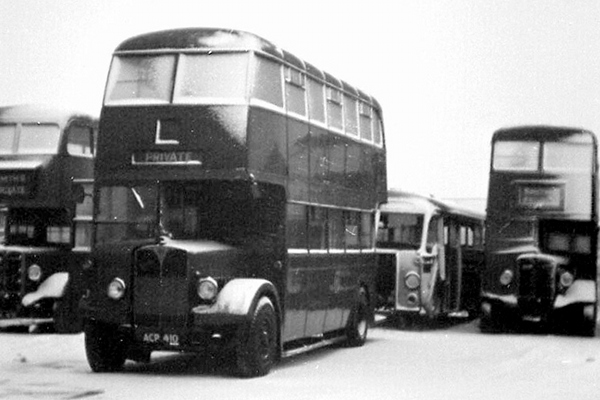
ACP 410 a 1947 AEC Regent III with a Park Royal H30/26R body ex Halifax JOC fleet number 226
acquired 1958.
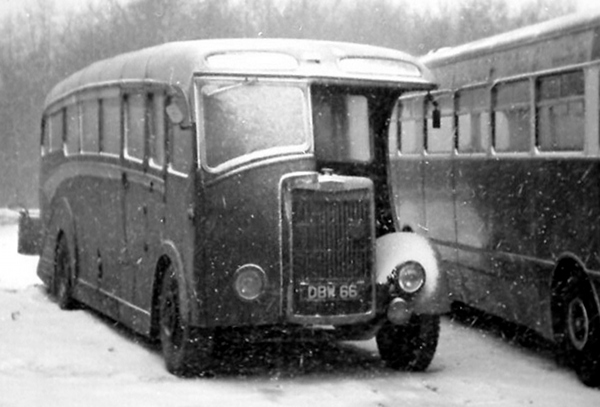
DBW 66 a 1948 Tilling-Stevens K6LA7 with Vincent body, which passed from Kemp's Motor Services with the formation of Chiltern Queens in July 1955.
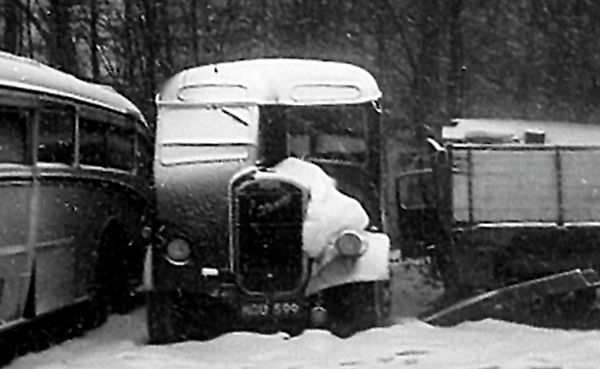
KGU 599, a 1949 Dennis Lancet with Burlingham body, acquired from Whites of Camberley in July 1959.
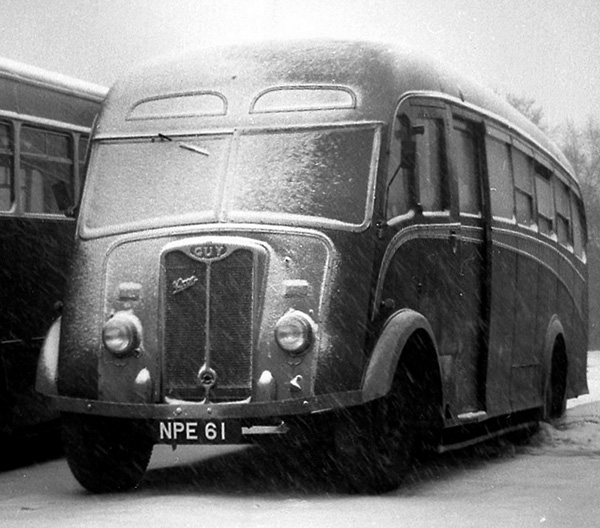
NPE 61 a 1949 Guy Vixen with Wadham body, acquired from Whites of Camberley in July 1959.
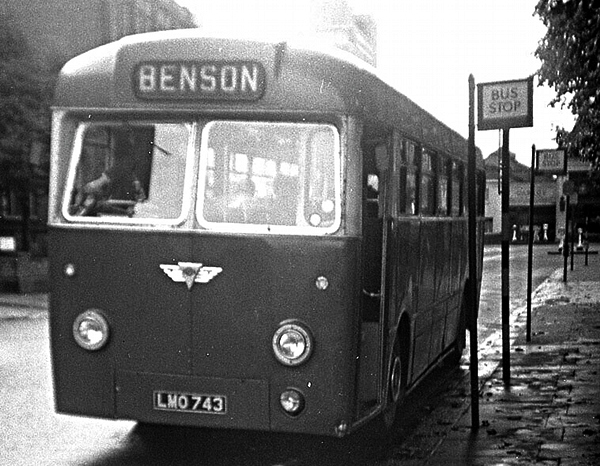
LMO 743 an AEC Reliance MU3RV new in October 1955 apparently with a with Yeates C41C body but the shot above is not a Yeates C41C. I also have information that it had a Duple Midland body, it must be that do you think.
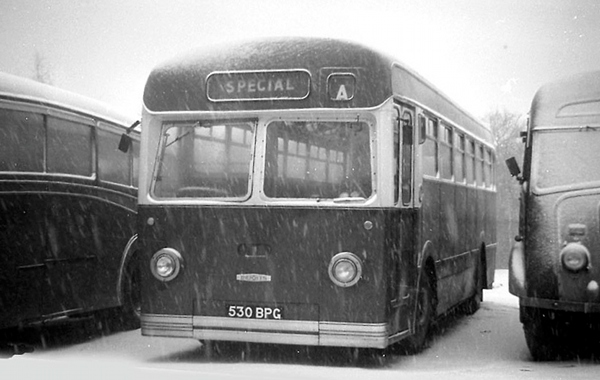
530 BPG the unique Dennis Pelican, with B44F Duple Midland body. New in 1956 as a Dennis demonstrator, acquired from Daisy Bus Service in August 1962.
I hope you liked the above shots but there are two things I would like to expand on from information I have received.
First the service life of 530 BPG the only Dennis Pelican to receive a body, new in 1956 it was used as a demonstrator by Dennis but there was not much interest so in 1957 it was sold to Yellow Bus Services of Stoughton, Guildford. In 1958 Yellow Bus Services was taken over by Aldershot and District and 530 BPG was sold to Trimdon Motor Services County Durham. Trimdon I think (if you know different you know what to do) sold it on to Daisy Bus Service of Brigg Lincolnshire and in 1962 it eventually arrived at Chiltern Queens with whom it stayed for 10 years. It is a tribute to the quality of Dennis manufacturing standards that a single prototype lasted for some 15 years in service.
Second in 1971 530 BPGs body was removed and fitted to an AEC Reliance the chassis was then scrapped, one of the contributors to this site actually tried to buy it for preservation but Chiltern Queens were asking for too much money, what a shame. Here it gets interesting as there are quite a few references on the internet that the Reliance that received the Pelican body was LMO 743. From reliable information (BBF 1965) received LMO 743 started life with a Yeates coach body and it still had that body in 1965, but the shot of LMO 743 above is obviously a front entrance bus body and the photograph was taken in the early 60s so there is something not quite correct there. If LMO 743 did receive the Pelican body in 1971 what body did it have in the shot above and why rebody it again for a third time when it was 16 years old especially with a body older than the one it already had? On saying that though Dennis would have spent good money to have a really good body put on it to pretty it up as a sales tool to hopefully sell more vehicles.
Ray Soper
09/2011
With thanks to Michael Wadman, Mike Grant, Roger Cox and Ian Thompson for their valuable information which enabled captions to accompany the shots.
10/09/11 - 08:03
This story that the Duple body on the Dennis Pelican was subsequently fitted to a Reliance has become something of a legend in the bus enthusiast world, yet it is, as Ray suggests, a bit of a puzzle. According to "Bus Lists on the Web", LMO 743 was delivered new in 1955 to Chiltern Queens with two identical buses, LMO 744 and 745, and they were all fitted with Duple B44F bodies. The Dennis Pelican, like the Lancet UF, had a very low driving position, and this is evident in the windscreen and frontal design of the vehicle. That body would have required extensive rebuilding at the front if it were to have been fitted to a Reliance. Why would LMO 743 have required a new body anyway? Perhaps an extensive rebuild was undertaken after accident damage using parts from the Pelican body. I would love to know the truth about this legend.
Roger Cox
10/09/11 - 08:05
A very interesting set of photographs.
Chiltern Queens was established in 1955 and one of the first purchases
was a batch of three Duple-bodied Reliances LMO 743-5. These are
shown on Bus Lists on the Web as having Duple bodies and I believe it
is an error in BBF3 showing 743/4 with Yeates bodies. LDL 896
certainly did have a Yeates body and looked very smart.
Attached is a photo by Jonathan Gulliver, reproduced with his permission, of all three of these Reliances together in about 1982.
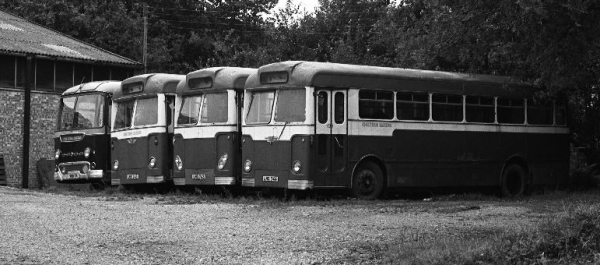
They appear
to be withdrawn and all had acquired reflective registration plates
and been rebuilt below the windscreen. LMO 743 even has twin headlamp
units set at a jaunty angle! The bodies are different from those on
the Dennis Pelican by virtue of the front dome treatment and
windscreen height - the Pelican seems to have had quite a low driving
position.
So there seems to have been two errors which have caused confusion.
One being in BBF3 and the other that one of these three was rebodied.
I have come across another reference to the Pelican body being used on
another chassis, but have not been able to pin it down further.
Jonathan is going to look through the rest of his photos to see if
there is one which will unlock the puzzle.
Hope this at least partially unravels the mystery.
David Beilby
10/09/11 - 08:08
The photo of LMO 743 is definitely the Duple Midland body. I think that the reference to a Yeates body must be an error: The PSVC AEC Reliance chassis list states that this vehicle carried the Duple Midland body from new. Also, according to my records, the Reliance that received the body from the Pelican was not this vehicle but was YNX 478.
Michael Wadman
10/09/11 - 08:09
There seem to have been a lot of crossed wires over LMO 743 down the years. Bus Lists On The Web, which gets most of its information from PSV Circle publications, has LMO 743-5 as AEC MU3RV808-10 all with Duple B44F from new. AEC MU3RV811-14 were supplied to other operators with Yeates coach bodies, two of them centre-entrance. In "The Oxford & Cilterns Bus Page" there is mention of LMO 743 receiving the Pelican's body, but Jack Passey, who worked in the Chiltern Queens workshop for 45 years, said it never happened; that was a different Reliance altogether.
Peter Williamson
10/09/11 - 13:38
I’ve now dug out my old South Central BBFs. The fourth edition (February 1965) lists LMO 743-5 as Duple B44F (by which I presume they mean Duple Midland) but the fifth edition (December 1965) lists LMO 743/4 as Yeates C41C. I’m pretty sure that the fifth edition is in error.
In the lists, they use letter codes to designate the bodies, and in the fourth edition the code for Duple B44F is b. However in the fifth edition b is used as the code for Yeates C41C and the code for Duple B44F has become c. LMO 743/4 are shown as b in the forth edition and still as b in the fifth edition, and I strongly suspect that this is an error and they forgot to change them.
Michael Wadman
10/09/11 - 14:53
Thanks, Ray Soper, for those wonderfully atmospheric photos. By a happy coincidence the Oxford Bus Museum were running a circular route in town today with three buses (1950 Regent III Weymann L27/26R PWL 413, 1960 Reliance Park Royal B44 756 KFC and 1967 Renown FWL 371 E) and the owner of the Reliance just happens to own the ex-Pelican-bodied Reliance, which he assures me ---bearing out Michael Wadman's words--- is YNX 478. On one trip the Regent III was deserted downstairs but thronged up top!
A good few years back I saw one of the CQ Guy Vixens in Passey's scrapyard at Benson.
That Tilling-Stevens was often seen by the iron railings at the side of Reading South station. At the time I didn't realise how rare it was. A similar postwar TS that has made it to the present day is GOU 732, once with Altonian of Alton, Hants and now in Wulfrun livery. Apparently the owner couldn't find a suitable David Brown 5-speed gearbox to replace the worn-out one he inherited, so he got a 6-speeder out of an ERF lorry and fitted it. Does that make this TS the only 6-speed halfcab bus?
Ian Thompson
10/09/11 - 16:13
A couple of photos on the web would seem to confirm Michael Wadman's view that the body was fitted to YNX 478:
http://www.photoboxgallery.com/transportfotos/photo?photo_id=1886129566&vendor_id=4534
http://www.flickr.com/photos/56252091@N03/5833307135/in/photostream
Interestingly, the first has one of the original Duple-bodied
Reliances behind!
What is also of interest is the way the front end was modified. The
need for this was clearly driven by the low driving position on the
original body, but the way of dealing with it was unexpected!
There is also a photo of the Dennis Pelican in original guise at
http://www.sct61.org.uk/yb530.htm
only recently added.
David Beilby
11/09/11 - 08:14
It is worth noting, I think, that the picture of the Pelican at the sct61 site shows the bus beside the old factory in Onslow Street, Guildford, that Dennis built and occupied from 1901. Then, in 1905 Dennis bought a 10 acre site at Woodbridge, and developed a factory that was to become its home for over 90 years. The Onslow Street site became the company's repair shop until it was sold in 1917.
Roger Cox
11/09/11 - 08:15
Regarding Ian Thompson's comment about Tilling-Stevens GOU 732, this no longer has the ex-ERF gearbox as it gave a top speed barely exceeding 30mph. The replacement overdrive gearbox is possibly the same 5-speed type that was fitted to the Bristol SC, as the arrangement of the gears is similar, with the top two upside down.
Peter Williamson
11/09/11 - 15:37
Would the David Brown gearbox in the lightweight Gardner 4LK powered Bristol SC be able to take the extra loads of the Gardner 6LW in a much heavier vehicle? David Brown gearboxes were not noted for robustness.
Roger Cox
11/09/11 - 15:38
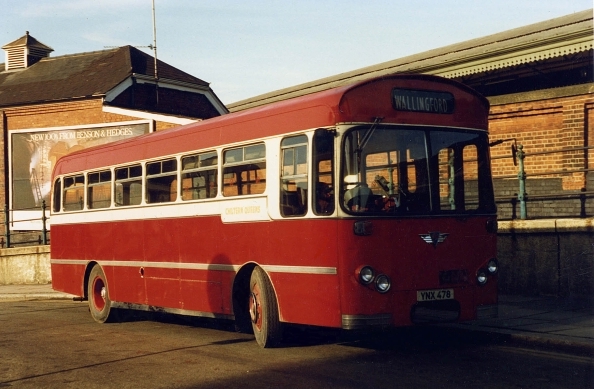
Photograph by ‘unknown’ if you took this photo please go to the copyright page.
Some of the comments in this thread about the bodies on the various Reliances have been very interesting. This shot shows YNX 478 carrying the body off the Pelican and as you can see it’s been fitted with a totally different front, presumably to accommodate the Reliance’s higher driving position.
Michael Wadman
24/10/11 - 13:51
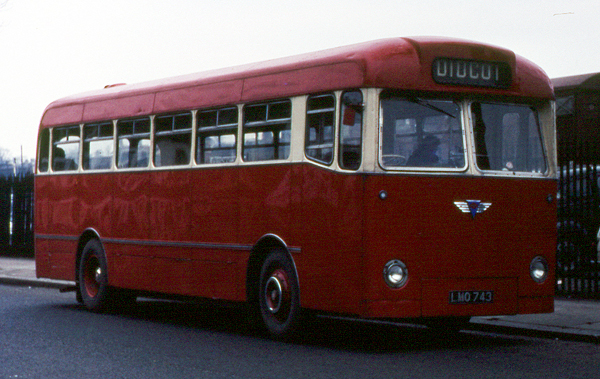
Copyright Roger Cox
This is a shot of LMO 743, one of the three Duple B44F bodied Reliances in the Chiltern Queens fleet. I took this photo in about 1970, in Oxford, and the bus did not yet sport the twin headlamps that it wears in Jonathan Gulliver's 1982 picture of the three Reliances together.
Roger Cox
07/06/15 - 10:24
As a driver with Chiltern Queens for 40 years may I please clear up a long standing query re these vehicles. The Dennis Pelican 530 BPG ran in it's original form until withdrawal in 1970, the body was then mounted on the chassis of YNX 478, acquired following severe fire damage for this project. The three LMO's were all operated until the end of there lives and when withdrawn were all scrapped.
Philip Smith
08/06/15 - 06:44
In the first photograph of this gallery, the former Halifax JOC Regent III - ACP 410 - was actually owned by Smith's of Reading, who had acquired it from North's, the dealer, in August 1959. It was withdrawn in November 1963. It never operated for Chiltern Queens.
John Stringer
08/06/15 - 06:47
Just to clarify a minor point, Duple (Midland) was established during 1956 so the bodywork on the three 1955 Reliances is correctly described as "Duple". The company acquired Nudd Bros & Lockyer of Kegworth in 1952, and from then until 1956 the factory's products were marketed as "Duple". In 1956 production moved to Loughborough and the new subsidiary Duple (Midland) was formed, its first new product being the Donington semi-coach. After 1962 the Duple (Midland) name was only used for bodywork on light-weight chassis, and by 1966 even these were being badged as Willowbrook products (Duple had acquired Willowbrook in 1958 to expand its Loughborough division).
Neville Mercer
16/06/15 - 08:28
On another forum, some of us have been puzzling over the type of curved windscreen that was used when the Pelican's body was fitted to YNX 478. Naturally, since it's a bus, we were thinking of bus windscreens, but nothing seemed quite right.
Eventually I came to a different conclusion. The answer is, I think, to be seen lurking behind LMO 743-5 in Jonathan Gulliver's photo. It's a Duple Britannia windscreen, but tilted slightly forward.
Peter Williamson
Comments regarding the above are more than welcome please get in touch via the 'Contact Page' or by email at obp-admin@nwframpton.com
If you have any bus related photographs that you would like to appear in a gallery on this website please send them to me by email at obp-admin@nwframpton.com
All rights to the design and layout of this website are reserved
Old Bus Photos from Saturday 25th April 2009 to Wednesday 3rd January 2024